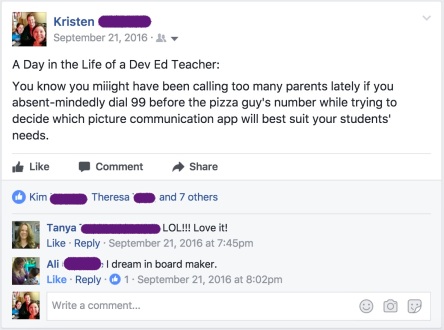
Ahhh, the life of a multi-tasker. I’m never just doing one thing. For those of you who are not teachers, dialling 99 is how you reach an outside line on a school phone. So, when I absent-mindedly do this on my cell phone, it never really works out. And believe me, I do it quite often. Every single day at school I’m calling parents. I’ve never talked to parents more in my life! I swear I talk to them more often than I talk to my own parents. In the Dev Ed world, talking to the parents is a large part of the role. Not only are my students extremely complicated medically, but they are also almost all non-verbal. So literally, I have to tell the parents everything that happened in the day that might influence their night at home. You know, they never really taught us this stuff in Teachers’ College (or… Bachelor of Education if you’re reading this Dr. W-H!), that one day, you too could be paid an awful lot of money to track someone else’s poop schedule. But, alas, these are the kinds of conversations that I get to have with parents on a daily basis.
Every time something of note happens, I get to pick up the phone. Oh, someone had a seizure? Call home. Someone is running out of food at school? Call home. Someone forgot their AFOs at school? Call home. Someone is running a fever? Call home. Someone is in pain? Call home. Someone threw up? Call home. Someone’s wheelchair broke? Call home. And every time I call home, I have to remember to press that dreaded 99, or I have to start all over again once the phone denies me by blaring obnoxious noises in my ear. There are a lot of things that happen throughout the day, thousands of decisions I have to make, and while some of these things can wait to be written in the communication book at the end of the day, many can not. It is because my students are not able to tell me how they are feeling, or what is going on with them that I have to call parents. They are the experts on their kids, and will share valuable insight with me at a moment of need in order to help make the best plan of care for their kid. Also, its just basic common courtesy to tell a parent why their kid is coming home wearing someone else’s pants.
As for the second part of that Facebook status, a lot of people have asked me “but what do you teach in a Dev Ed classroom”, and I always answer with “What don’t I teach!”. I suppose the answer here would be like theoretical physics and advanced calculus, but I do a lot of things that “ordinary” teachers wouldn’t be doing. Spending hours surfing the app store for that one picture communication app that just might work, is just one of them. Do you know how hard it is to find apps that are both age appropriate for teenagers, AND ability appropriate (which is roughly pre-school or less?). The answer is impossible. There are a lot of excellent apps out there designated as “Special Education Apps”, but within those are mountains and mountains that are just too sophisticated for kids who are learning how to just use an iPad at all. And don’t even get me started on how much they cost, and how annoying it is when you thought you found one that would work, only to download it and find out that it is way too complex. So, it really isn’t all that unusual to find me on a Friday night, or accidentally still at school at 7:00 PM on a Tuesday while I sit and surf the app store, trying out any combination of words like “communication” and “toddler” and “cause and effect”, to find that one app that might just interest one of my 14-21 year old students.
And that’s why the pizza guy knows that the address I gave him is “the school”.
 So, what does a day in the life actually look like?
So, what does a day in the life actually look like?
